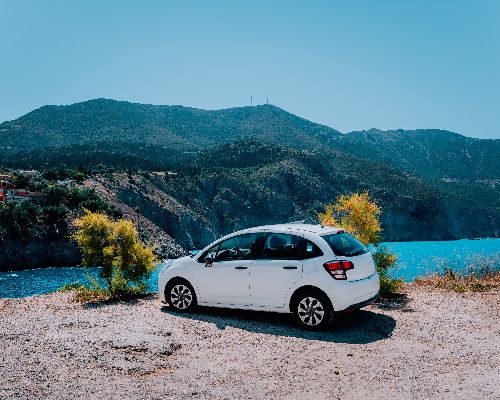Travel to Greece by Car
Greece at a Glance
Greece is located in the south of Europe. The state includes the mainland and numerous islands. Greece has many bays on the Mediterranean, which attracts mainly beach lovers in the summer. Greece has a Mediterranean climate with hot, dry summer months and mild winters. The capital is Athens and the official language is modern Greek.
The Greek mainland is becoming increasingly popular as a tourist destination and offers visitors a number of possible routes for round trips. Probably the greatest magic in a journey on the mainland is the relatively unspoiled landscape, its diversity and the impressive mountain scenery.
Drive to Greece
Greece can be entered by car from any of its land neighbors.
At the ferry ports of Venice, Ancona and Bari you can get to the Greek mainland or to the island of Corfu.
The connections from Ancona to Igoumenitsa and Patras are particularly popular – probably because they represent a good compromise between travel time and costs. For more information, please contact our partner for cheap ferry connections.
Despite some imponderables, the land route through Austria, Slovenia, Serbia and Macedonia is a real alternative. Most parts of the route are now built as a comfortable highway, and there are also plenty of gas stations.
The biggest advantage of the Balkan route to Greece is that you save on ferry costs here. Ferry fees vary greatly, depending on, accommodation comfort and travel season.
The motorway tolls are a bit higher on the Austria-Balkan route than through Italy.
Greece can be entered by car from any of its land neighbors.
At the ferry ports of Venice, Ancona and Bari you can get to the Greek mainland or to the island of Corfu.
The connections from Ancona to Igoumenitsa and Patras are particularly popular – probably because they represent a good compromise between travel time and costs. For more information, please contact our partner for cheap ferry connections.
Despite some imponderables, the land route through Austria, Slovenia, Serbia and Macedonia is a real alternative. Most parts of the route are now built as a comfortable highway, and there are also plenty of gas stations.
The biggest advantage of the Balkan route to Greece is that you save on ferry costs here. Ferry fees vary greatly, depending on, accommodation comfort and travel season.
The motorway tolls are a bit higher on the Austria-Balkan route than through Italy.
“Perhaps travel cannot prevent bigotry, but by demonstrating that all peoples cry, laugh, eat, worry, and die, it can introduce the idea that if we try and understand each other, we may even become friends.”
Maya Angelou Tweet
Getting Around Greece
The Greek motorways connect the northern parts of the country with Athens and the peninsula of Pelopennes. From the center of Greece you can easily go exploring as it is in the immediate vicinity of Athens. Renting a car in the city or at the airport gives travelers the opportunity to explore the capital’s surroundings. The regions of Viotia, Evrytania and Fthiotida are known for their breathtaking scenery, their far-reaching panorama and their enchanting towns.



Greece travel guide - Travel tips
Special traffic rules
In Greece, the 0.5-alcohol limit applies. For novice drivers who have a driver’s license for less than two years, only 0.2 alcohol limit applies.
The speed limit in Greece is as follows:
- Downtown 50 km/h
- Highways 90 km/h
- Highways at 130 km/h
Do not forget the first aid kit!
Make frequent stops
Pre-trip Maintenance
Entry requirements
- Children need their own children’s passport
- Recommended is the International Green Insurance Card
Gas price Greece and other countries
In Greece, super gasoline costs around 18 cents per liter more than in Germany. The diesel is about the same price. Cheap fuel can be found in the Czech Republic, here the liter of diesel costs about 10 cents less than in Germany. The super gasoline is even 15 cents less. The other countries on the route have comparable fuel costs with Germany.
Advantages of Car Ferries
- Relaxing. The vacation begins already during the journey. The crossing is fun for kids and adults as well.
- In time. There are no traffic jams or pilot strikes on the open sea. As a rule, the ferries reach their destination on time.
- Time-saving. Most ferries are pretty fast. The ships travel the shortest route, do not need breaks and are also on the road at night.
- Rental car unnecessary.
See below which companies are operating from Italy to Greece, and search ferry ticket to view availability by date and book your ticket at the best price!
SUPERFAST
ANEK LINES
MINOAN LINES
ANEK LINES
MINOAN LINES
AGOUDIMOS LINES
SUPERFAST
ENDEAVOR LINES
VENTOURIS FERRIES
AGOUDIMOS LINES
ENDEAVOR LINES
VENTOURIS FERRIES
AGOUDIMOS LINES
SUPERFAST
ANEK LINES
MINOAN LINES
SUPERFAST
ANEK LINES
MINOAN LINES
Here is an overview of the possible routes
From the north of Europe, the fastest and cheapest route goes via the Czech Republic, Slovakia, Hungary, Serbia and Macedonia. If you come from the south of Germany and would like to travel to Greece by car, you are more likely to choose Austria, Slovenia, Croatia, Serbia and Macedonia. Depending on the place of departure and the chosen route to Greece, the journey takes about 2300 km and takes more than one day.
From the south of Germany the way through Austria, Slovenia, Croatia and Serbia as well as Macedonia remains the first choice. Interesting stopovers include Lake Millstatt and Lake Osslach in Austria, as well as the capitals of Croatia – Ljubljana, Croatia – Zagreb, Serbia – Belgrade and Macedonia – Skopje. In addition, this route is very scenic in many parts.
The tolls on this route are significantly lower according to Internet information provided by Via Michelin.
After the war years in the former Yugoslavia, the Italian route has become the most popular itinerary. At the ferry ports of Venice, Ancona and Bari you can translate to the Greek mainland or to the island of Corfu. The connections from Ancona to Igoumenitsa and Patras are particularly popular – probably because they represent a good compromise between travel time and costs.
Anyone arriving in Italy has the choice between different short or longer ferry routes and can decide for themselves how long he wants to travel the Mediterranean.
Driving from Northern Europe to Greece through the Balkans
The land route to Greece has some advantages and disadvantages compared to the arrival by ferry. The advantage is that you can travel much faster in Greece by car and save a day. Also, the cost of the ferry ride is fairly high.
When traveling through Serbia, the green card is required – a passport is no longer needed since June 2010, so the ID card is sufficient.

